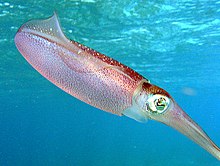Lophotrochozoa
Appearance
| Lophotrochozoa Temporal range:
| |
|---|---|

| |
| Caribbean reef squid or Sepioteuthis sepioidea is a complex lophotrochozoan. | |
| Scientific classification | |
| Domain: | Eukaryota |
| Kingdom: | Animalia |
| Clade: | ParaHoxozoa |
| Clade: | Bilateria |
| Clade: | Nephrozoa |
| (unranked): | Protostomia |
| (unranked): | Spiralia |
| Superphylum: | Lophotrochozoa Halanych et al., 1995 |
| Phyla | |
Lophotrochozoa (/ləˌfɒtroʊkoʊˈzoʊə/, "crest/wheel animals") is a clade of protostome animals within the Spiralia. The taxon was established as a monophyletic group based on molecular evidence.[2][3]
Groups
The Lophotrochozoa has basal Cycliophora and Mollusca groups, and more derived Lophophorate, Nemertea and Annelida groups.[4][5]
With the introduction of Platytrochozoa and Rouphozoa, one candidate phylogeny is pictured below – though other studies recover a range of different alternative possibilities:[6][7][8][9][10][11][12][13]
A number of fossil taxa can be identified as early Lophotrochozoans, even if their precise affinity remains contested.
References
- ^ Budd, Graham E.; Jackson, Illiam S. C. (January 5, 2016). "Ecological innovations in the Cambrian and the origins of the crown group phyla". Philosophical Transactions of the Royal Society B: Biological Sciences. 371 (1685): 20150287. doi:10.1098/rstb.2015.0287. PMC 4685591. PMID 26598735.
- ^ Halanych, K.M., Bacheller, J., Liva, S., Aguinaldo, A. A., Hillis, D.M. and Lake, J.A. (17 March 1995). "18S rDNA evidence that the Lophophorates are Protostome Animals". Science. 267: 1641–1643. doi:10.1126/science.7886451. PMID 7886451.
{{cite journal}}: CS1 maint: multiple names: authors list (link) - ^ Hervé, Philippe; Lartillot, Nicolas; Brinkmann, Henner (May 2005). "Multigene Analyses of Bilaterian Animals Corroborate the Monophyly of Ecdysozoa, Lophotrochozoa, and Protostomia". Molecular Biology and Evolution. 22 (5): 1246–1253. doi:10.1093/molbev/msi111. PMID 15703236.
- ^ Nesnidal, Maximilian P.; Helmkampf, Martin; Meyer, Achim; Witek, Alexander; Bruchhaus, Iris; Ebersberger, Ingo; Hankeln, Thomas; Lieb, Bernhard; Struck, Torsten H. (2013-11-17). "New phylogenomic data support the monophyly of Lophophorata and an Ectoproct-Phoronid clade and indicate that Polyzoa and Kryptrochozoa are caused by systematic bias". BMC Evolutionary Biology. 13: 253. doi:10.1186/1471-2148-13-253. ISSN 1471-2148.
{{cite journal}}: CS1 maint: unflagged free DOI (link) - ^ Laumer, Christopher E.; Bekkouche, Nicolas; Kerbl, Alexandra; Goetz, Freya; Neves, Ricardo C.; Sørensen, Martin V.; Kristensen, Reinhardt M.; Hejnol, Andreas; Dunn, Casey W. "Spiralian Phylogeny Informs the Evolution of Microscopic Lineages". Current Biology. 25 (15): 2000–2006. doi:10.1016/j.cub.2015.06.068.
- ^ Paps, Jordi; Baguñà, Jaume; Riutort, Marta (2009-10-01). "Bilaterian Phylogeny: A Broad Sampling of 13 Nuclear Genes Provides a New Lophotrochozoa Phylogeny and Supports a Paraphyletic Basal Acoelomorpha". Molecular Biology and Evolution. 26 (10): 2397–2406. doi:10.1093/molbev/msp150. ISSN 0737-4038. PMID 19602542.
- ^ Struck, Torsten H.; Schult, Nancy; Kusen, Tiffany; Hickman, Emily; Bleidorn, Christoph; McHugh, Damhnait; Halanych, Kenneth M. (2007-01-01). "Annelid phylogeny and the status of Sipuncula and Echiura". BMC Evolutionary Biology. 7: 57. doi:10.1186/1471-2148-7-57. ISSN 1471-2148. PMC 1855331. PMID 17411434.
{{cite journal}}: CS1 maint: unflagged free DOI (link) - ^ Hausdorf, Bernhard; Helmkampf, Martin; Meyer, Achim; Witek, Alexander; Herlyn, Holger; Bruchhaus, Iris; Hankeln, Thomas; Struck, Torsten H.; Lieb, Bernhard (2007-12-01). "Spiralian Phylogenomics Supports the Resurrection of Bryozoa Comprising Ectoprocta and Entoprocta". Molecular Biology and Evolution. 24 (12): 2723–2729. doi:10.1093/molbev/msm214. ISSN 0737-4038. PMID 17921486.
- ^ Struck, Torsten H.; Wey-Fabrizius, Alexandra R.; Golombek, Anja; Hering, Lars; Weigert, Anne; Bleidorn, Christoph; Klebow, Sabrina; Iakovenko, Nataliia; Hausdorf, Bernhard (2014-07-01). "Platyzoan Paraphyly Based on Phylogenomic Data Supports a Noncoelomate Ancestry of Spiralia". Molecular Biology and Evolution. 31 (7): 1833–1849. doi:10.1093/molbev/msu143. ISSN 0737-4038. PMID 24748651.
- ^ "Cycliophorans - Cycliophora - Details - Encyclopedia of Life". Encyclopedia of Life. Retrieved 2017-09-02.
- ^ Lu, Tsai-Ming; Kanda, Miyuki; Satoh, Noriyuki; Furuya, Hidetaka (2017-05-29). "The phylogenetic position of dicyemid mesozoans offers insights into spiralian evolution". Zoological Letters. 3: 6. doi:10.1186/s40851-017-0068-5. ISSN 2056-306X.
{{cite journal}}: CS1 maint: unflagged free DOI (link) - ^ Temereva, Elena N.; Kuzmina, Tatyana V. (2017-07-31). "The first data on the innervation of the lophophore in the rhynchonelliform brachiopod Hemithiris psittacea: what is the ground pattern of the lophophore in lophophorates?". BMC Evolutionary Biology. 17: 172. doi:10.1186/s12862-017-1029-5. ISSN 1471-2148.
{{cite journal}}: CS1 maint: unflagged free DOI (link) - ^ Luo, Yi-Jyun; Kanda, Miyuki; Koyanagi, Ryo; Hisata, Kanako; Akiyama, Tadashi; Sakamoto, Hirotaka; Sakamoto, Tatsuya; Satoh, Noriyuki (2017-12-04). "Nemertean and phoronid genomes reveal lophotrochozoan evolution and the origin of bilaterian heads". Nature Ecology & Evolution. doi:10.1038/s41559-017-0389-y. ISSN 2397-334X.
Further reading
Wikispecies has information related to Lophotrochozoa.
- Podsiadlowski, R (2009). "Phylogeny and mitochondrial gene order variation in Lophotrochozoa in the light of new mitogenomic data from Nemertea". BMC Genomics. 10: 364. doi:10.1186/1471-2164-10-364.
{{cite journal}}: CS1 maint: unflagged free DOI (link)
